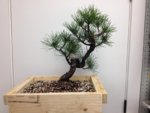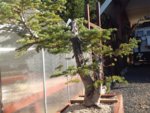You are using an out of date browser. It may not display this or other websites correctly.
You should upgrade or use an alternative browser.
You should upgrade or use an alternative browser.
collecting trees
- Thread starter August44
- Start date
bonsaichile
Omono
That's a great deal. I have to pay $10 per tree in advanceThe regulations are... pay the $20.00 for a permit and you can collect 20 trees where I live. Don't know if it would be the same where you live
Here is a photo of the rooting hormone I use. Also a photo of another plant/tree starter that I have used before I started using the high in phosphorus liquid. Would like a comments on both products if I could. I threw that high phosphorus stuff in the trash. One never knows
Attachments
River's Edge
Imperial Masterpiece
Having read through this thread so far i would like to offer a couple of suggestions.I have been collecting some trees for the past 2 months in the mountains behind town. I have collected Larch, Lodgepole, Ponderosa pine, White Bark pine, and Western White pine. Every time I go I have to go a little higher to get into an area where they are still dormant, and I am about to run out of mountain. It seems that the pines go to sleep with the candles area pushed out a bit and are covered with a light, rusty brown sheath. When the time is right in the spring that area starts to grow and the candles are formed. Being new to this art, I wanted to ask about when to dig and when to no longer dig. When the candle shows signs of growth of any kind is it time to stop? I realize that it will depend on how I dig them. I try to dig and collect the entire root system of the tree and then take home in soil from the mountain and repot after trimming off a little of any tap roots, and raking out old soil in the correct soil for pines in growing pots. I then don't do anything with them until I see signs that new growth coming along, and then I do minimal until next spring. Could I get you to give me advice etc so I will not be doing this wrong?? Thanks much in advance. Peter
1. Select trees that are in slightly different locations. Ie: look for those growing in a pocket formed by intersecting slabs, not cracks. These tend to have more compact root systems with many more feeder roots to begin with close to the trunk.
2. I find the best collection time in the spring just before the candles or buds start moving on the conifers. Second best time late august to early October. My zone is very similar to yours i believe.
3. Retaining some soil is important but it is more important that the roots are collected with as little damage as possible.
4. Boxes are used more often than pots due to the size of the root ball retained and the shape one is working towards. Ie: flatter
5. Take your time on the dig start outside of the foliage drip line in a circle. You can remove soil and compact the rootball slowly to reduce the size without cutting off all the roots.
6. keep the roots wet by misting while working and transporting the newley collected tree.
I collect Shore Pines, Mountain Hemlock, Sub-Alpine Fir as these shown.
Attachments
Having read through this thread so far i would like to offer a couple of suggestions.
1. Select trees that are in slightly different locations. Ie: look for those growing in a pocket formed by intersecting slabs, not cracks. These tend to have more compact root systems with many more feeder roots to begin with close to the trunk.
2. I find the best collection time in the spring just before the candles or buds start moving on the conifers. Second best time late august to early October. My zone is very similar to yours i believe.
3. Retaining some soil is important but it is more important that the roots are collected with as little damage as possible.
4. Boxes are used more often than pots due to the size of the root ball retained and the shape one is working towards. Ie: flatter
5. Take your time on the dig start outside of the foliage drip line in a circle. You can remove soil and compact the rootball slowly to reduce the size without cutting off all the roots.
6. keep the roots wet by misting while working and transporting the newley collected tree.
I collect Shore Pines, Mountain Hemlock, Sub-Alpine Fir as these shown.
I will concur with all your points but #2. Baker City is a harsher climate with much colder winters and a short season more like Central OR. I’ve collected in the fall there successfully. But you need a greenhouse to extend the fall season.
One final thing to consider. Whitebark Pine are in serious trouble. They are the most susceptible North American species to White Pine Blister Rust. Pine beetle epidemics are hammering them as well. I will never intentionally collect a Whitebark Pine regardless of the legality in a region. Limber Pine occur NE of Baker City. They are a proven species for bonsai with better bark.
Could someone explain to me the importance of collecting the specimens with native soil. If the soil falls away while digging, should I fill the pot with the native soil or go with bonsai soil? I read the post about the fungi in the soil and the trees need for it. Just want to make sure of the best way to do this next spring. Also, if you end up with a bare root tree would you dip it in a root hormone before replanting? How about using Vit B as a helper when first collecting? I appreciate all the help here. I am trying to do this correctly. Peter
River's Edge
Imperial Masterpiece
Could someone explain to me the importance of collecting the specimens with native soil. If the soil falls away while digging, should I fill the pot with the native soil or go with bonsai soil? I read the post about the fungi in the soil and the trees need for it. Just want to make sure of the best way to do this next spring. Also, if you end up with a bare root tree would you dip it in a root hormone before replanting? How about using Vit B as a helper when first collecting? I appreciate all the help here. I am trying to do this correctly. Peter
You are going to get opposing methods/variations with this question. As with most practices, various approaches have been and are still used. The approach used takes into consideration the best way to collect the roots safely, the best way to transition the root ball for Bonsai purposes.
Simply put, beneficial fungi, supplements, native soils can all be claimed to be needed. Also, it is almost impossible to remove all traces of beneficial fungi, native soil. Proving they are required is another matter.
My approach that works for me is to collect as many roots as possible and keep as much local soil around the roots for safe transport back home. Then in all cases i very slowly with chopstick and gentle water spray, bareroot the tree. Place in appropriate sized grow box or container using straight pumice as substrate. Depending on the species and time of year, i may tent for humidity. My reasoning is based on the following practices and understanding.
1.Collected trees are rarely in top health and their best chance of survival is to give them the best growing conditions for the roots as soon as possible. Free draining soil with excellent air porosity, moisture and sun.
2. I only collect when the tree is dormant to minimize damage to the tree and root system. Maintaining the native soil in the roots for transport protects the roots better.
3. I only collect trees that are collectable! Ie: Root base is compacted by natural restrictions and or soil is amenable to extraction.
4. The key factor in collecting i believe is collecting and preserving the roots, followed by maintaining foliage for recovery. ( conifers )
If i were collecting other species i would adapt my practises to suit the soil, climate and trees collected.
5. Personally i have seen no evidence in scientific literature or difference in actual practise with supplements. I have discontinued purchasing or using them.despite the mountains of anecdotal accolades and devout followers.
I have attached a couple of pictures to illustrate the results of this approach!
Attachments
Similar threads
- Replies
- 9
- Views
- 2K
- Replies
- 1
- Views
- 1K












